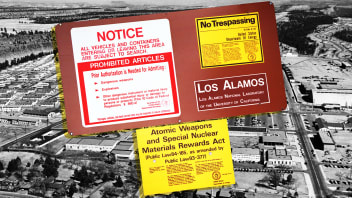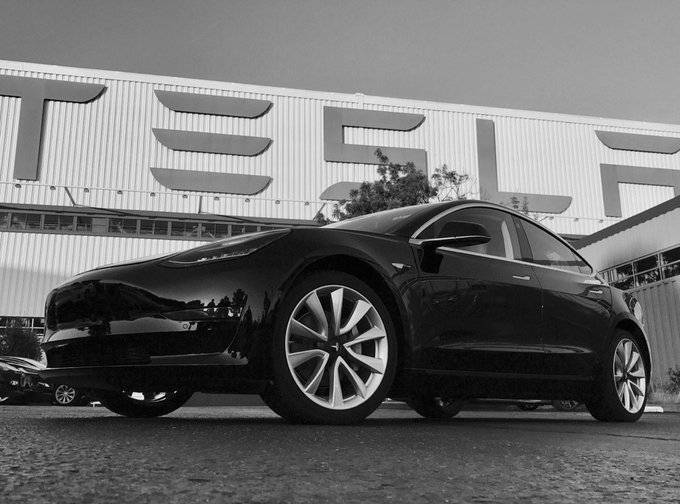First Production Model 3
Tesla CEO Elon Musk’s attacks against “sanctimonious journalists” and “divisive” unions have captured the public’s attention in recent weeks, but Musk has bigger problems on his hands: His automaker has struggled to deliver on the promise of a mass-market fully electric car, the Model 3 sedan.
When Musk delivered the first Model 3s last year, he jokingly warned customers and employees that the firm would be entering “production hell.”
But according to several former Tesla insiders, it’s not a joke.
Cars built by hand, fires that turned a paint sprayer into a flamethrower, rampant quality problems, and a bloated workforce plague the factory, the insiders say. That’s on top of an injury rate that Reveal News reports is higher than the industry average, with shocking examples. These interconnected symptoms of Tesla’s “production hell” raise questions about the company’s entire approach to manufacturing, which diverges significantly from the auto industry’s practices that have been honed over decades.
The sources requested anonymity to speak because of Tesla’s history of trying to catch leakers, including once reportedly leaving a “fingerprint” in memos to find who divulged them to the press.
Throughout its history Tesla has been successful in convincing Wall Street that it is more technology company than auto manufacturer and is worth more than Ford. Its software startup-style culture has produced stunning designs and cutting-edge in-car technologies that delight consumers.
But ultimately Tesla’s business is to make cars—and a lot of them. Tesla said it plans to make as many as 1 million Model 3s per year by the end of the decade. Yet it has already fallen behind its targets for Model 3 production. Stumbling on the Model 3 from practically day one, Tesla’s frantic attempts to meet Musk’s ambitious production targets are exacting a heavy cost on its people, products, and culture.
In the week following the official start of Model 3 production last summer, Musk was asked during Tesla’s second quarter earnings call if the first round of vehicles off the assembly line were “validation prototypes” built to test parts and the production system.
“These are not prototypes in any way,” he replied. “They’re not validation anything. They are full production cars.”
But according to two former Tesla employees, they were hand-built cars made with unvalidated parts.
“That black Model 3, that first production one that Elon said was the first production one? That was a crock of shit,” said one former employee whose work took him to almost every part of the factory. “I walked that thing through the shop, I watched the dudes build it in the back area, the little cave area [known internally as ‘Area 51’], and he drove it off.” The first Model 3s were “ hand walked” through the paint shop, because machines weren’t programmed to recognize that car, the former employee added.
“So they were just sitting there as props,” said a former high-level employee who confirms that the July event cars were hand-built prototypes. The Wall Street Journal previously reported these Model 3s were hand-built.
On top of that, a recently filed lawsuiton behalf of Tesla shareholders accuses the company of securities fraud, alleging management misrepresented Tesla’s ability to begin mass-production of Model 3s in 2017. The lawsuit cites more than 10 former employees to support the allegation that Musk and other top Tesla executives either knew, or were reckless in not knowing, their claims were false. Tesla filed a motion to dismiss the lawsuit, saying it spoke about the challenges publicly in “frank and plain language” like “production hell.”
In a statement to The Daily Beast, Tesla stood by Musk’s comment and referred to an earlier statement that said, in part, “every vehicle manufacturing line in the world has both manual and automated processes” and said it would “take some time to fine tune the line for higher volumes.”
The auto industry typically builds a run of “pre-production” vehicles to validate, or test, parts and production processes as well as the vehicles themselves before beginning to make “production” vehicles for delivery to customers.
“This helps established automakers avoid the prolonged ramp and ‘production hell’ that Tesla has experienced with Model 3,” said Dave Sullivan of automotive-research firm Autopacific and a former auto manufacturing supervisor.
Tesla effectively skipped that step and instead went straight to “production” and evolved its production system over time.
Part of this critical planning and testing phase includes thorough statistical process control and repeatability and reproducibility testing, said Sam Abuelsamid, a senior research analyst at Navigant Research.
“If you look at the anecdotal reports we’ve heard about quality issues with Tesla vehicles, it seems like they haven’t implemented a lot of those kinds of processes,” he said.
More than 90 percent of new Model S and X vehicles contained defects requiring rework, Reuters reported in November, citing nine current and former employees. Two sources told The Daily Beast they estimate approximately 90 percent of all vehicles have required repair or rework at Tesla’s “end of line” stations.
“That sounds like something is severely wrong,” said Sullivan.
Both Sullivan and Abuelsamid said anything greater than 5 percent of vehicles needing rework would be a cause for serious concern. Tesla said it thoroughly inspects every car it produces and that the majority of issues are minor and resolved in minutes.
Because rework is labor-intensive at any automaker, it’s likely contributed to Fremont’s ballooning headcount, which in turn contributes to management challenges, said Sullivan.
“If there’s a very high defect rate today, you can only assume that the people they are hiring are gearing up to make repairs on the vehicles coming off the line,” he said.
The plant has “a workforce that’s twice the size of what it’s required to build the car,” said one former high-level employee. With more than 10,000 factory employeesmaking about 100,000 cars last year, Tesla’s Fremont facility makes about 10 vehicles per employee at a factory that never made fewer than 26 vehicles per employee (and made as many as 74 vehicles per employee) when it was a joint venture between General Motors and Toyota.
Tesla does have non-production workers at the Fremont factory and manufactures components like seats in-house that other automakers source from suppliers, both of which inflate the plant’s headcount.
“Given that we do more of the manufacturing ourselves, it is not fair to compare our vehicles per employee to another company’s vehicle per employee,” Tesla told The Daily Beast.
Meanwhile, Tesla has failed repeatedly to meet Musk’s ambitious targets for Model 3 production, including his 2016 estimate of 100,000 to 200,000 vehicles produced in the second half of 2017. In early 2017, Musk predicted that Tesla would build 5,000 cars per week by the end of the year, but it still hasn’t achieved that goal. In mid-2017, Musk lowered the target to 1,500 cars for the entire third quarter of 2017, but Tesla ended up producing only 260 cars over that period.
These failures have put Model 3 production under Wall Street’s microscope and have increased the pressure on workers tasked with ramping up production.
The size of the Fremont workforce combined with the frantic pace of work and production has led to weaknesses in the plant’s maintenance operation, two sources said. They described shutdowns and snafus that regularly cost valuable production time caused by lack of maintenance.
Most dramatically, it has resulted in fires.
Two former employees who worked in the paint shop told The Daily Beast that at least three fires have broken out at Fremont’s paint operations since 2016. Lack of maintenance led to paint building up on paint-spraying machines and grounding straps, the sources said, and in at least one instance sparks ignited the paint and practically turned the paint sprayer into a flamethrower.
“Literally it’s a torch fucking flying around, the paint spraying, the paint’s on fire, scorching the car,” one former paint shop employee said.
In April, CNBC reported that one fire had broken out in the primer station of the Fremont paint shop, which characterized this fire as “small” and “immediately contained and extinguished in a matter of seconds.” CNBC subsequently reportedthat the fire was one of four in the factory since 2014, that it caused the paint shop to shut down for at least two shifts, and forced Tesla to decommission two burnt sprayer robots.
“Any fire in any manufacturing facility of any type, especially three in less than two years, should be sounding more than fire alarms,” said Sullivan, the auto analyst.
Tesla said it’s been working to improve safety in the paint shop in recent months, including a “maintenance effort involving cleaning and calibration.”
One former employee who regularly worked in the paint shop also said that lack of maintenance caused paint buildup on a conveyor, resulting in a Model S body falling into a dip tank. The accident caused an 8-hour shutdown of the paint line and required the draining of 80,000 gallons of coating in order to recover, the source said. Lack of maintenance also caused a 30-year-old overhead conveyor to break and drop a 1,500-pound battery rack, the source added.
“This is false. We are not aware of a single instance where lack of maintenance caused any issue like what’s described above,” a Tesla spokesperson said.
Pushing for additional maintenance was a struggle, according to Seth Love, a former maintenance engineer who left the company in December. Giving the example of Fremont’s south paint shop, where bumpers and other plastic parts were painted, he said “that shop was so old that they kept holding off on maintenance.” Love said managers told him maintenance was deferred in favor of temporary fixes “just to get the plant going again.”
“So it was constant battles, arguing back and forth with management, saying ‘give me the time to do the actual repairs,’” Love said.
“We regularly clean and maintain all the surfaces, ducting and nozzles,” Tesla said. “We continue to have regularly scheduled maintenance for paint operations.”
To speed up production, two former paint shop employees said temperatures in the oven used to dry paint were raised. This has led to incidents of vehicle bodies and bumpers being ruined by excessive heat and thrown out, the sources said.
“This is false. It’s simply not our process to increase temperature to shorten the baking time,” a Tesla spokesperson said.
Though sources say Tesla management has tried to improve safety by changing the plant’s layout, adding protective barriers, removing cubicles from the factory floor, and emphasizing safety to workers, they said pressure to increase production outweighed the effort. Tesla’s struggle to prevent the unsafe practices described by sources, which the company said are not approved processes, further illustrates the management challenges the factory faces.
“It sounds like they are scrambling to get as much production as they can from limited capacity and running their equipment as hard as they can,” said Abuelsamid. “Often times the major cause of injuries is not the design of the equipment, but improper use and maintenance.”
Workplace injuries are not a new phenomenon at the Fremont plant. Studies of Tesla’s workplace injury data by both WorkSafe (PDF) and Reveal News showed that workers there were injured at a significantly higher rate than the industry average—722 injuries last year, according to Reveal. Reveal also reported graphic examples of the kinds of injuries Tesla’s workers have sustained, noting that “workers have been sliced by machinery, crushed by forklifts, burned in electrical explosions and sprayed with molten metal.”
In response, Musk tweeted, “It is strange that big auto companies literally have thousands more factory injuries than Tesla & millions more auto deaths, but somehow get less coverage. We are not perfect, but we’re doing our best to make clean energy real & be a good company.”



